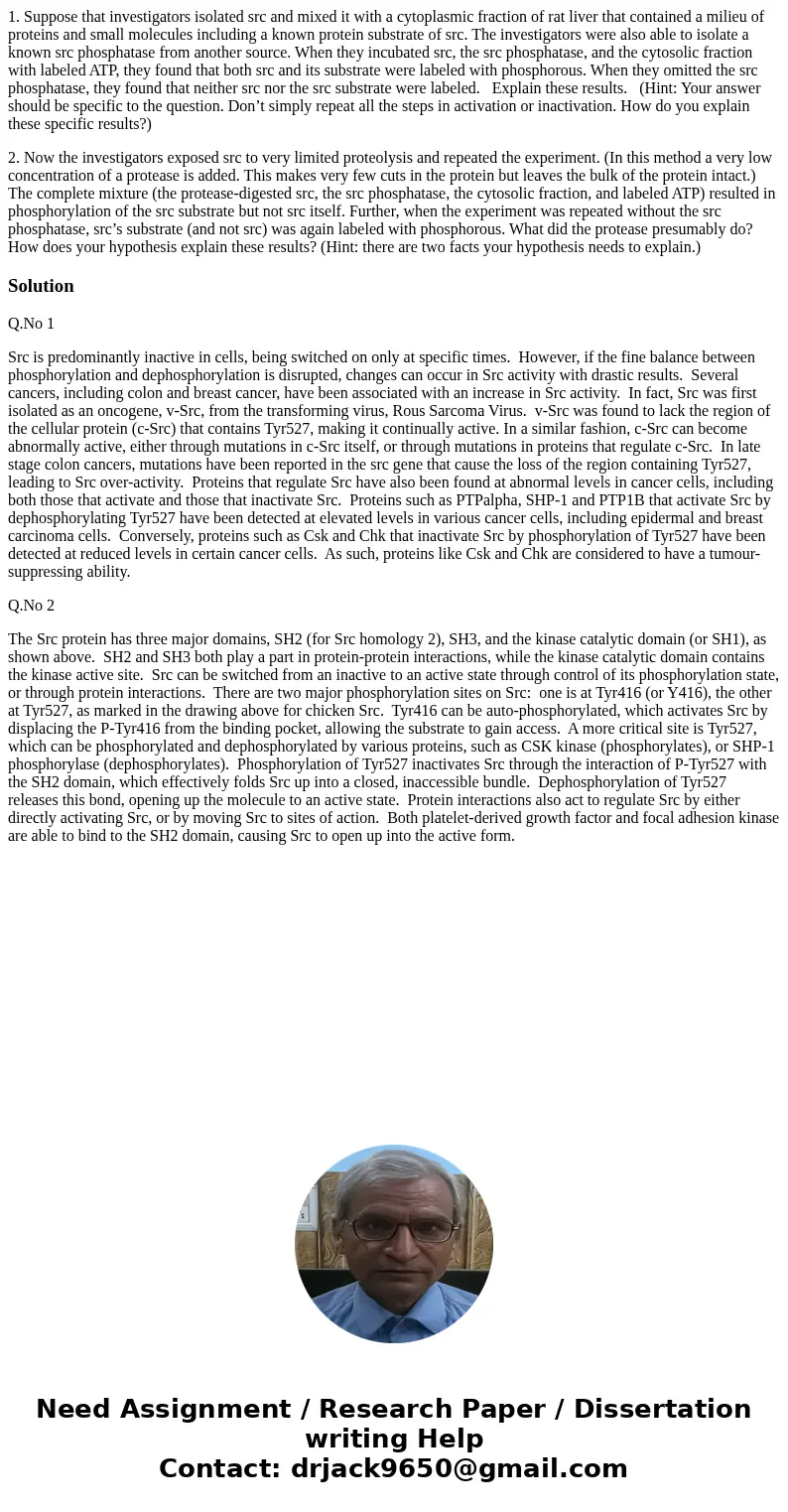1 Suppose that investigators isolated src and mixed it with
1. Suppose that investigators isolated src and mixed it with a cytoplasmic fraction of rat liver that contained a milieu of proteins and small molecules including a known protein substrate of src. The investigators were also able to isolate a known src phosphatase from another source. When they incubated src, the src phosphatase, and the cytosolic fraction with labeled ATP, they found that both src and its substrate were labeled with phosphorous. When they omitted the src phosphatase, they found that neither src nor the src substrate were labeled. Explain these results. (Hint: Your answer should be specific to the question. Don’t simply repeat all the steps in activation or inactivation. How do you explain these specific results?)
2. Now the investigators exposed src to very limited proteolysis and repeated the experiment. (In this method a very low concentration of a protease is added. This makes very few cuts in the protein but leaves the bulk of the protein intact.) The complete mixture (the protease-digested src, the src phosphatase, the cytosolic fraction, and labeled ATP) resulted in phosphorylation of the src substrate but not src itself. Further, when the experiment was repeated without the src phosphatase, src’s substrate (and not src) was again labeled with phosphorous. What did the protease presumably do? How does your hypothesis explain these results? (Hint: there are two facts your hypothesis needs to explain.)
Solution
Q.No 1
Src is predominantly inactive in cells, being switched on only at specific times. However, if the fine balance between phosphorylation and dephosphorylation is disrupted, changes can occur in Src activity with drastic results. Several cancers, including colon and breast cancer, have been associated with an increase in Src activity. In fact, Src was first isolated as an oncogene, v-Src, from the transforming virus, Rous Sarcoma Virus. v-Src was found to lack the region of the cellular protein (c-Src) that contains Tyr527, making it continually active. In a similar fashion, c-Src can become abnormally active, either through mutations in c-Src itself, or through mutations in proteins that regulate c-Src. In late stage colon cancers, mutations have been reported in the src gene that cause the loss of the region containing Tyr527, leading to Src over-activity. Proteins that regulate Src have also been found at abnormal levels in cancer cells, including both those that activate and those that inactivate Src. Proteins such as PTPalpha, SHP-1 and PTP1B that activate Src by dephosphorylating Tyr527 have been detected at elevated levels in various cancer cells, including epidermal and breast carcinoma cells. Conversely, proteins such as Csk and Chk that inactivate Src by phosphorylation of Tyr527 have been detected at reduced levels in certain cancer cells. As such, proteins like Csk and Chk are considered to have a tumour-suppressing ability.
Q.No 2
The Src protein has three major domains, SH2 (for Src homology 2), SH3, and the kinase catalytic domain (or SH1), as shown above. SH2 and SH3 both play a part in protein-protein interactions, while the kinase catalytic domain contains the kinase active site. Src can be switched from an inactive to an active state through control of its phosphorylation state, or through protein interactions. There are two major phosphorylation sites on Src: one is at Tyr416 (or Y416), the other at Tyr527, as marked in the drawing above for chicken Src. Tyr416 can be auto-phosphorylated, which activates Src by displacing the P-Tyr416 from the binding pocket, allowing the substrate to gain access. A more critical site is Tyr527, which can be phosphorylated and dephosphorylated by various proteins, such as CSK kinase (phosphorylates), or SHP-1 phosphorylase (dephosphorylates). Phosphorylation of Tyr527 inactivates Src through the interaction of P-Tyr527 with the SH2 domain, which effectively folds Src up into a closed, inaccessible bundle. Dephosphorylation of Tyr527 releases this bond, opening up the molecule to an active state. Protein interactions also act to regulate Src by either directly activating Src, or by moving Src to sites of action. Both platelet-derived growth factor and focal adhesion kinase are able to bind to the SH2 domain, causing Src to open up into the active form.

 Homework Sourse
Homework Sourse